Virtual Bundles
11/03/2025
Summary
What is the Virtual Bundles feature on TikTok Shop and how can it benefit sellers?
- Virtual Bundles allow sellers to group existing products into a single package without physical bundling, increasing average order value, boosting customer satisfaction, and helping clear slow-moving inventory by pairing with popular items.
- This feature creates a new product ID for the bundle, enabling real-time shared inventory management and a unified listing visible to shoppers.
Who can use Virtual Bundles and what are the key requirements or limitations for sellers?
- Currently, Virtual Bundles are only available to sellers using Seller Shipping (3PL) or Fulfilled by TikTok (FBT); sellers using TikTok Shipping (4PL) cannot access this feature.
- Each bundle SKU can include up to 25 sub-product SKUs, and sellers can create up to 100 bundle variations within a single Virtual Bundle.
How do sellers create, publish, and manage Virtual Bundles on TikTok Shop?
- Sellers create Virtual Bundles via Seller Center by selecting products, adding bundle details (brand, description, hazardous info), choosing a main product to set category, and publishing for review.
- Inventory management tools in Seller Center help track relationships between bundles and individual SKUs, showing stock levels and linked products to optimize stock allocation.
How can sellers fulfill and track orders for Virtual Bundles?
- Orders for Virtual Bundles can be fulfilled and tracked through Seller Center, TikTok Shop APIs (requiring developer support), or the Shopify 1P App (no developer needed).
- Sellers must create Virtual Bundles in Seller Center even if using API or app integrations for fulfillment.
What are some important distinctions and FAQs about Virtual Bundles sellers should know?
- Virtual Bundles differ from Combined Listings; bundles create a new product ID, while combined listings link existing product IDs visually.
- A single product SKU can be part of up to 50 different Virtual Bundles, and the bundle’s category and attributes depend on the main product selected.
- The system displays clear “virtual bundle” tags and stock messages to help sellers monitor bundle inventory effectively.
- This feature is currently in the whitelist phase. If you would like access to this feature or need more information, please contact your Account Manager.
- This feature is currently only available for sellers using Seller Shipping (e.g. 3PL) or Fulfilled by TikTok (FBT)
Product Overview
Virtual Bundles refers to a group of existing products that are sold together as a single package, but the items are not physically bundled together in a warehouse. With Virtual Bundles, sellers will be able to:- Increase average order value: Encourage shoppers to purchase additional products they might not have initially considered.
- Increase customer satisfaction: Shoppers can conveniently purchase complementary products together, saving time and effort.
- Clear out old inventory: Make slow-moving products more appealing to shoppers by bundling them with more popular products.
How It Works
- Verify your shipping solution: Currently, Virtual Bundles only work with Seller Shipping (also known as 3PL) or Fulfilled by TikTok (FBT). Verify that you are using Seller Shipping or read this Shipping Solutions Feature Guide for more information.
- Go to the Virtual Bundles tool: Log into Seller Center, go to Products on the left-hand navigation bar, then select Manage Products. In the top-right corner, hover your mouse over the green downward arrow next to Add new product, then click Virtual Bundle. You'll be redirected to a new page to create a Virtual Bundle.
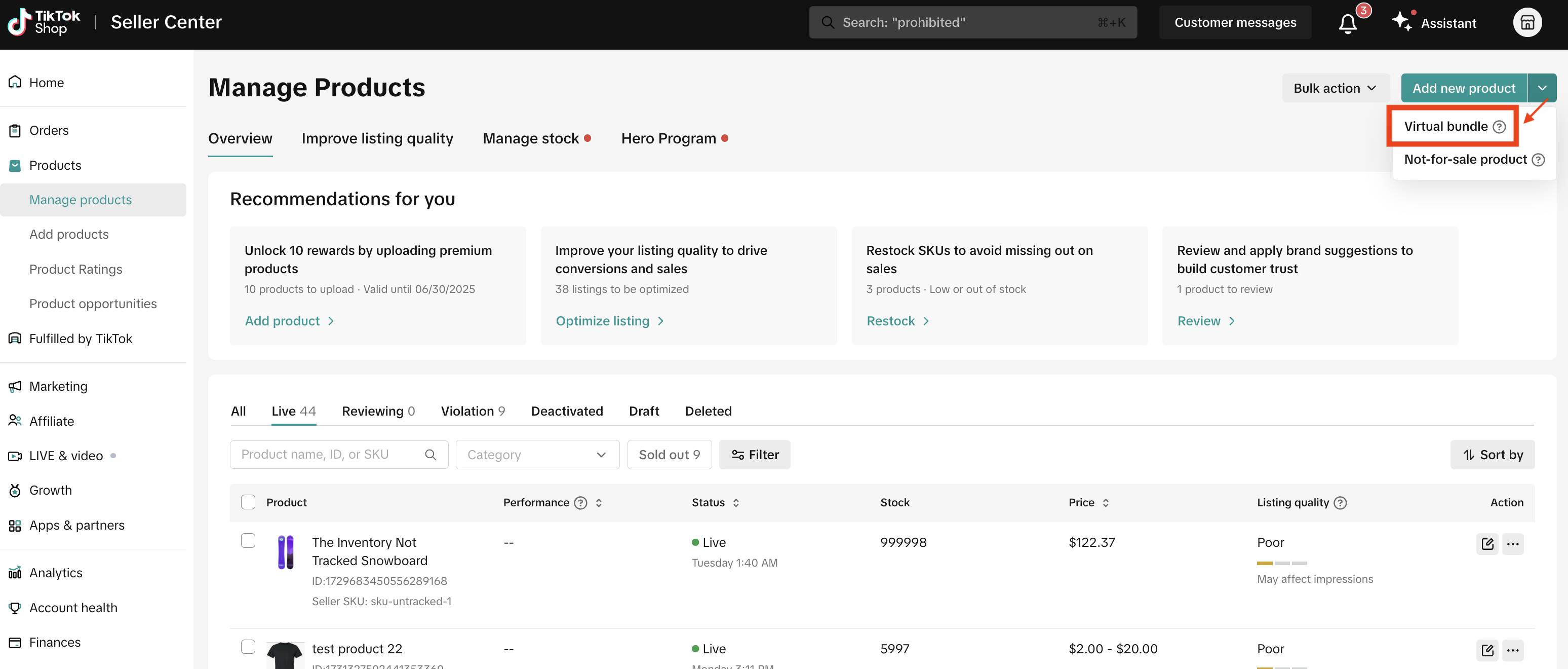
- Create a Virtual Bundle: Select the products you want to include in your bundle. Please note that you can include a maximum of 25 items (also known as sub-product SKUs) in a single bundle. You can continue to add items to a single bundle by selecting Select SKUs under the designated Bundle or SKU name. You're also now able to mix-and-match bundle items across certain product categories. For details on what product categories can be bundled together, please see the FAQs.
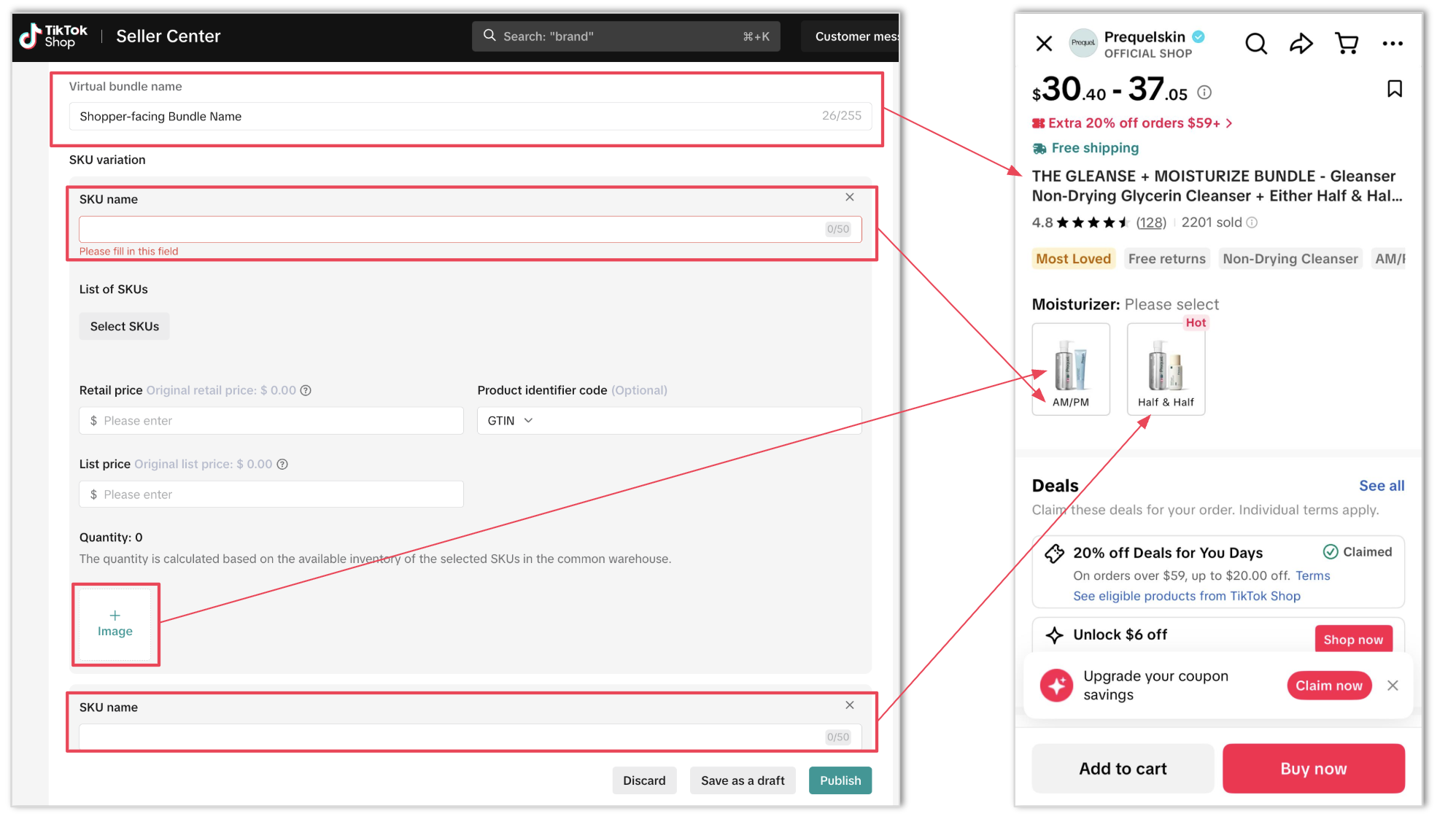
- Add product information: Input key product details about your bundle, such as the brand, bundle description, materials, hazardous materials information, and more. Here, you'll also choose the main product of the Virtual Bundle which will determine the listing's product category.
- Publish your Virtual Bundle: Finalize all other listing requirements and publish your Virtual Bundle(s) for review. Once your listing is created, it will appear on your product listings as well as a label designating it as a Virtual Bundle!
 NOTE: Sellers using API or app integrations MUST create virtual bundles in Seller Center. After the products are listed, sellers can then fulfill and track these orders either through Seller Center or API/app.
NOTE: Sellers using API or app integrations MUST create virtual bundles in Seller Center. After the products are listed, sellers can then fulfill and track these orders either through Seller Center or API/app.Managing Virtual Bundles
We've introduced several features in the Manage Stock (tab within Manage Products) section of Seller Center to help you better manage your virtual bundle inventory.These features are designed to help you easily locate and manage the relationship between virtual bundles and the individual products included in the bundle (e.g. sub-SKU), reducing effort and supporting more efficient stock allocation.
We've introduced several ways to help you better manage your virtual bundle inventory:
| Feature | Description | Visual |
| Tags | You'll now see a "virtual bundle" tag at the SKU and Product ID (PID) level, making it clear which products are part of a virtual bundle. | 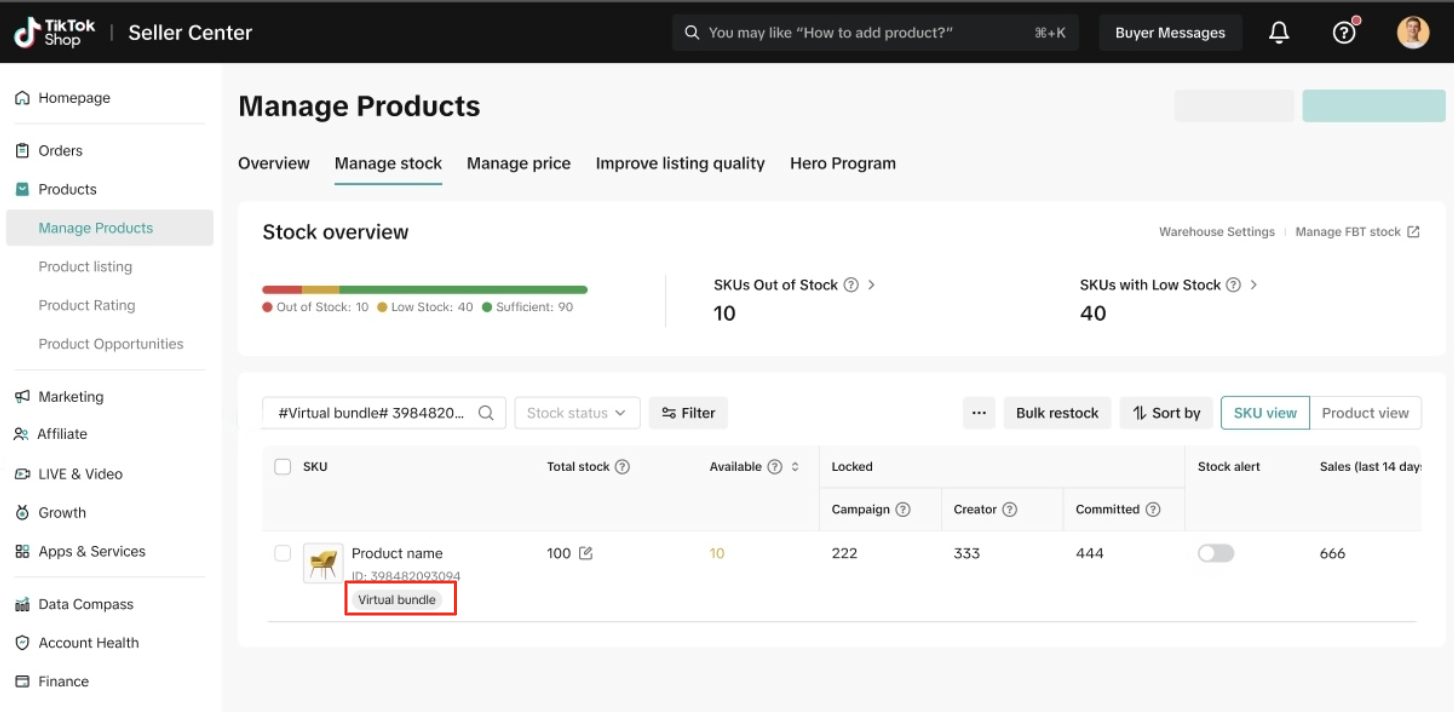 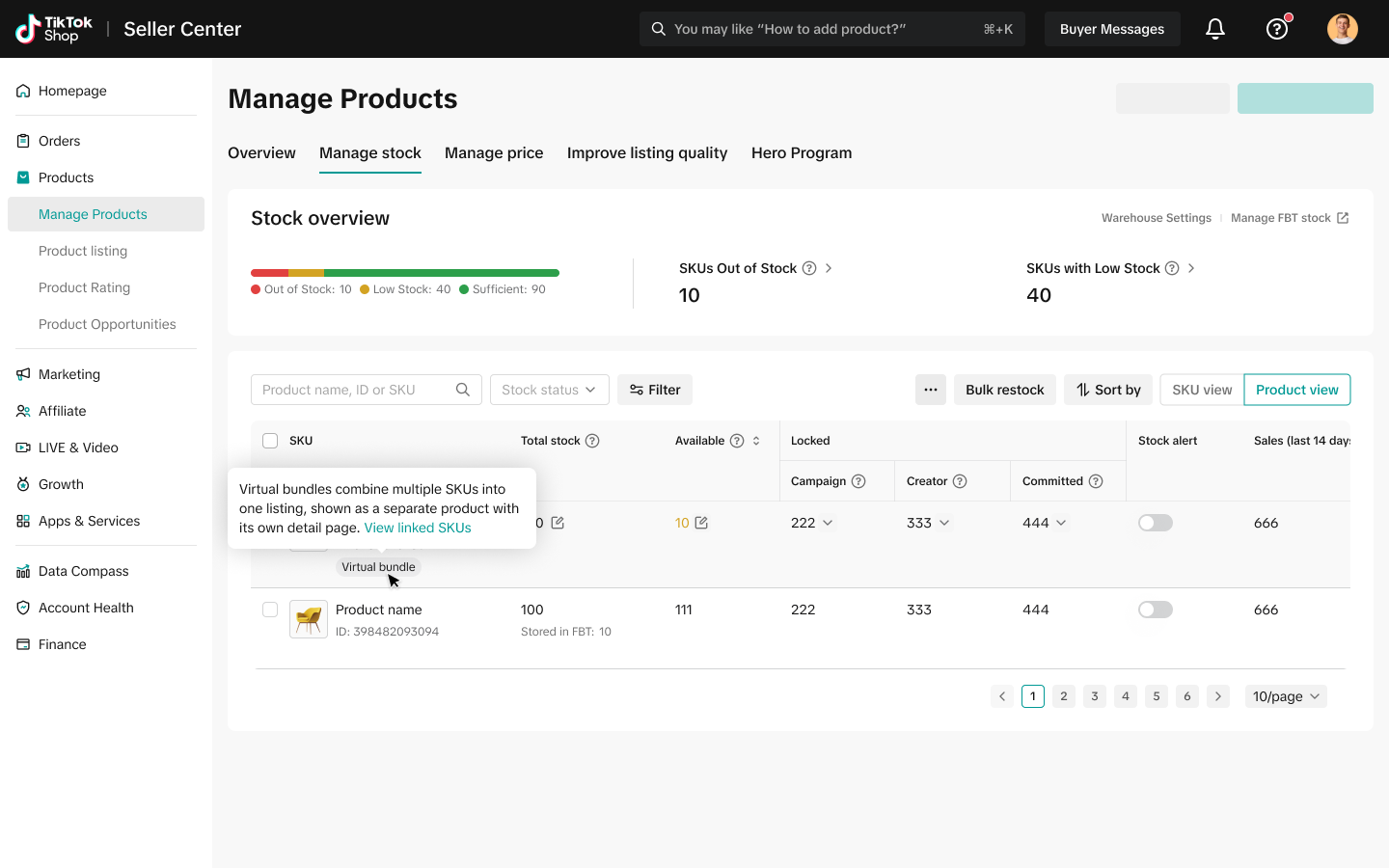 |
| In-platform messaging | When inventory is out or running low for a virtual bundle, a message will now be displayed by default (instead of requiring a hover) explaining that virtual bundle stock is determined by the lowest-stocked individual product of the bundle. This message also includes a link to auto-filter and display all linked individual products (i.e. sub-SKUs). | 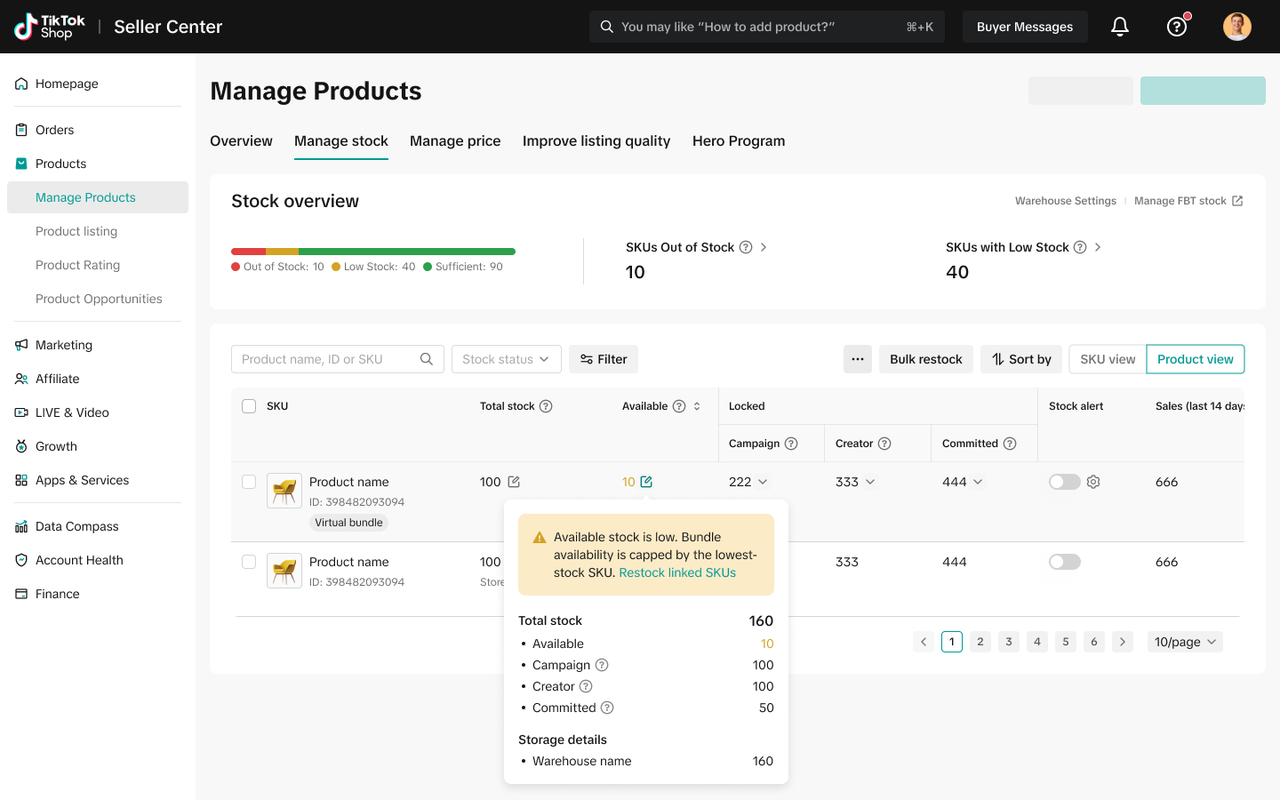 |
| Linked products and virtual bundles | If you're viewing an individual product that is part of a virtual bundle (i.e. sub-SKU), a hyperlinked message will appear on the stock update widget. Clicking this link will show all linked virtual bundle SKUs in the SKU view of Manage Stock. | 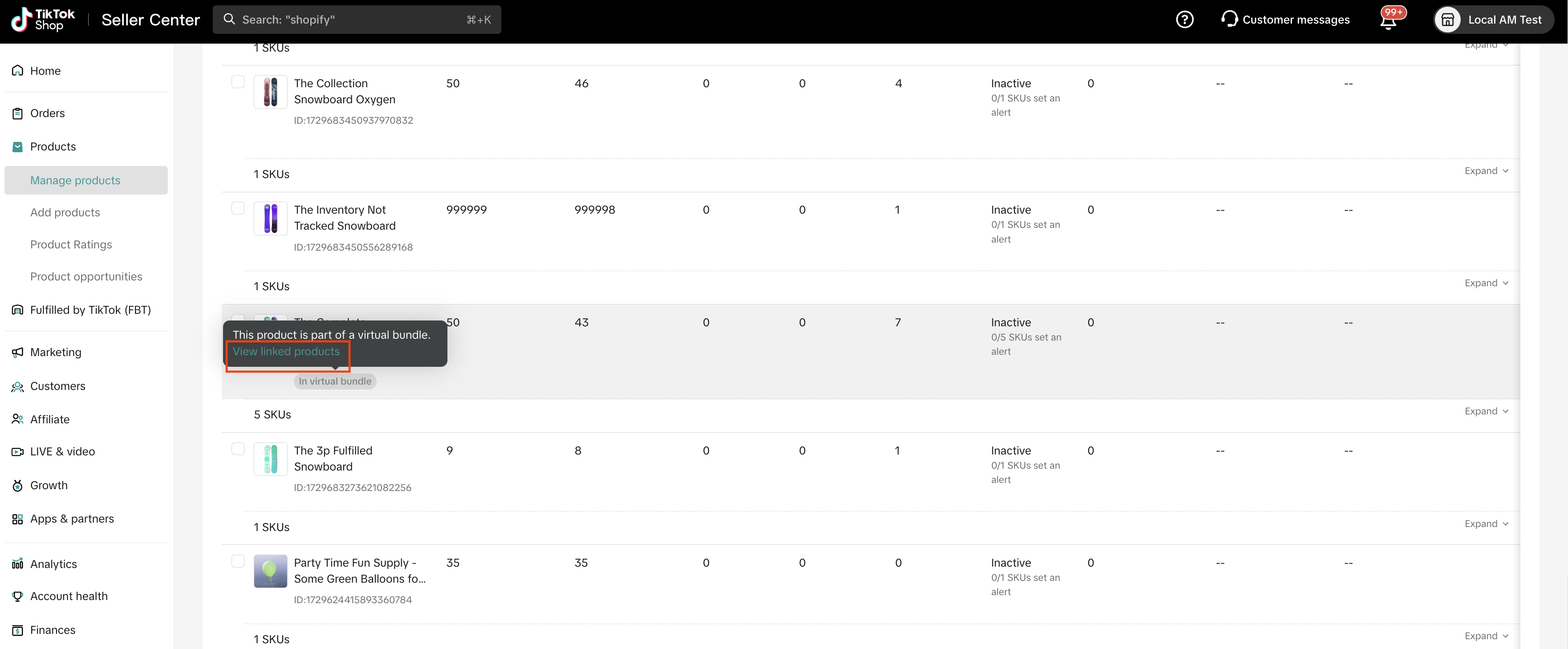 |
FAQs
- Can I use Virtual Bundles if I am using 4PL (also known as TikTok Shipping)? Currently, no. The Virtual Bundles feature is only available to sellers using 3PL (also known as Seller Shipping) or FBT (Fulfilled by TikTok).
- Is this the same as Combined Listings? No, these are different. Virtual Bundles bundle multiple existing products into a single, new product ID for purchase. Combined Listings visually connect different, existing product IDs (PIDs) to give shoppers a unified shopping experience where they can effortlessly jump between the combined product listings.
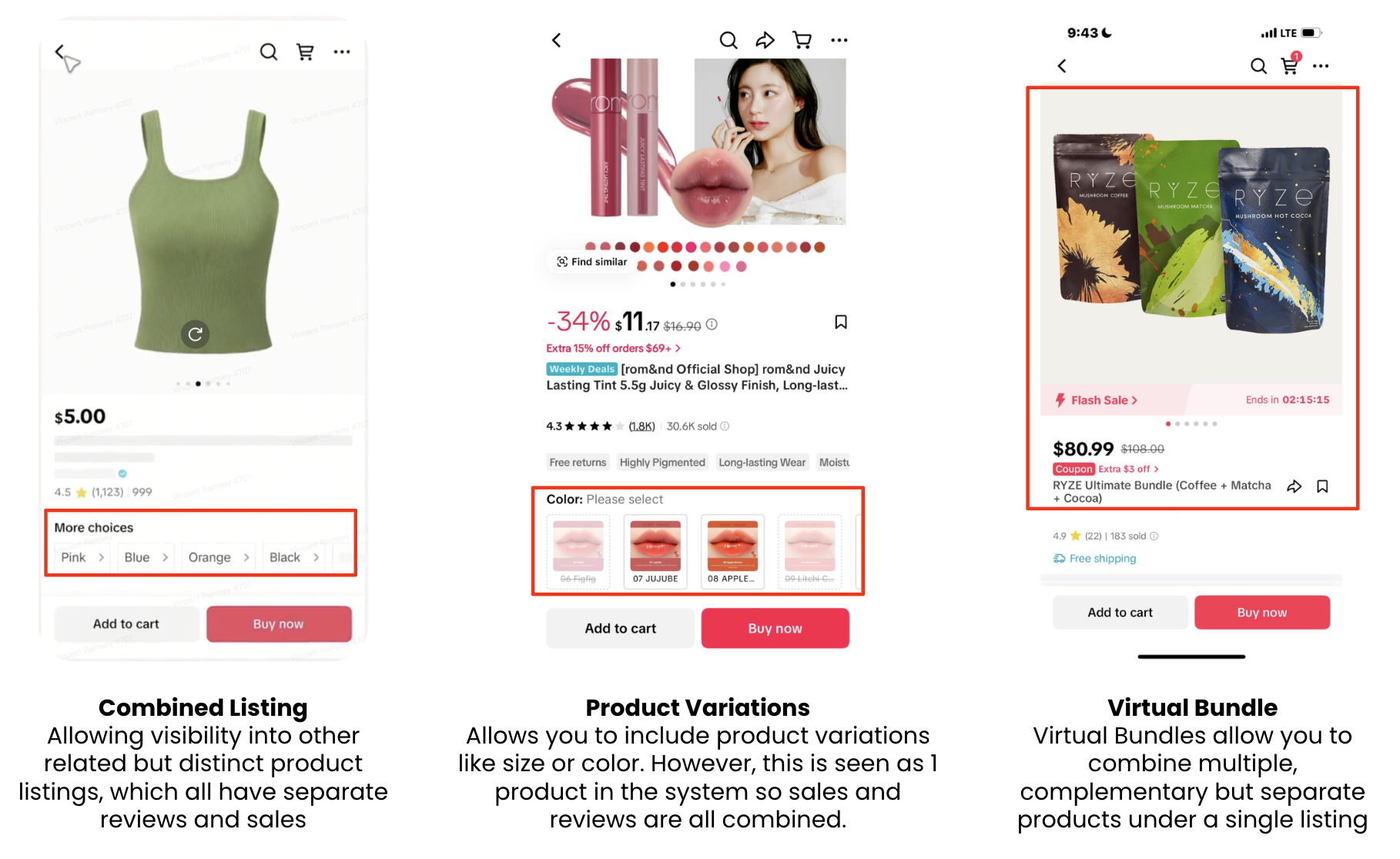
- How do I fulfill and track my virtual bundles? Virtual bundles can only be created through TikTok Shop Seller Center. Sellers can fulfill and track their orders in three ways: through Seller Center, TikTok Shop APIs, or the Shopify 1P App.
- TikTok Shop Seller Center: List the product as explained in the section above, and fulfill and track it in Seller Center as you would with your other products.
- TikTok Shop API: This requires in-house developer resources to integrate with the TikTok Shop partner platform. Please contact your Account Manager to set up a meeting with TikTok Shop tech support before using the API. See here for more details.
- Shopify 1P App: No in-house developer resources are required. Sellers can use the Shopify 1P app to fulfill orders and manage reconciliation. For assistance, people reach out to your Account Manager.
- Which categories are allowed to be combined in virtual bundles? The allowed Categories that can be cross-combined in Virtual Bundles includes:
|
|
|
- What's the difference between normal bundle deals and a virtual bundles? With normal bundle deals, the system suggests similar items to buyers, enabling them to purchase more items in the same transaction. Each product has its own product link and does not share inventory. With virtual bundles, the system creates a new product ID for the bundled product. Normal bundles and virtual bundles have individual product links but share inventory in real-time.
- Is there a limit to the number of Virtual Bundle SKUs a seller can create? Yes, within a single Virtual Bundle, you can have up to 100 SKUs (e.g. up to 100 bundle variations or bundle options).
- How many product SKUs can be included in a single bundle? Within each bundle SKU (e.g. a bundle variation or bundle option), a seller can include up to 25 sub-products SKUs or items.
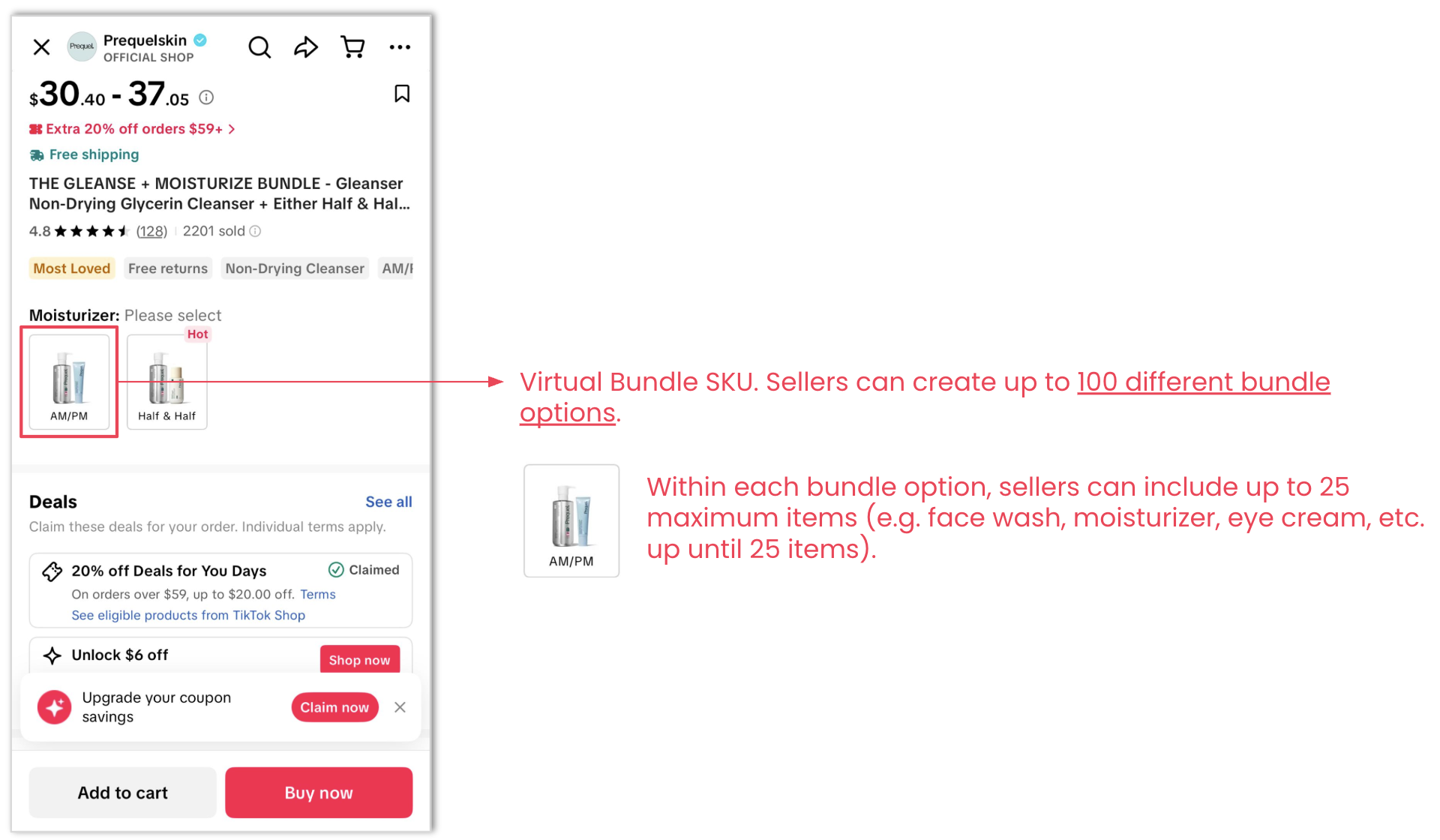
- How is the category and attributes of a Virtual Bundle determined? The category of the Virtual Bundle product is determined by the category of the main product selected within the bundle. Similarly, the attributes of the bundle, including keywords, will also be based on the main product. This selection will affect traffic to the bundle.
- Can a single product SKU be part of multiple Virtual Bundles? Yes, one product ID can be referenced by up to 50 group sets of virtual bundles.
You may also be interested in

List with a URL
Note: This feature is currently in beta to a limited set of pre-selected sellers. Introduction: Wh…

Made-to-Order (MTO)
Introduction: What is Made-to-Order (MTO)? Made-to-order is a new listing option available for eligi…

Applying for Category Permission
Introduction Some product categories on TikTok Shop are restricted and require sellers to apply for…
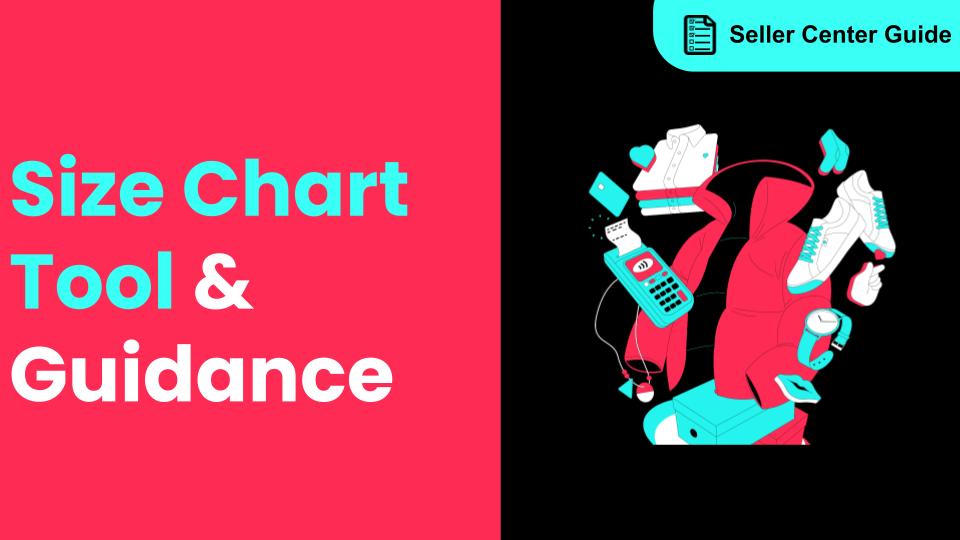
How to Use Size Chart Tool & Guidance
Introduction to our Size Chart Tool With the Size Chart tool, you can now update key sizing informat…

Edit products in your shop
Introduction to editing products in your shop Maintaining accurate and appealing product listings is…

Luxury Resale Products and Uploading Certificates of Authent…
What are Luxury Resale Products? Luxury Resale products are luxury items, including pre-owned luxury…

TikTok for Shopify: Promotions Sync
Overview: Shopify sellers can now sync Promotions/Discounts created on Shopify directly to TikTok Sh…
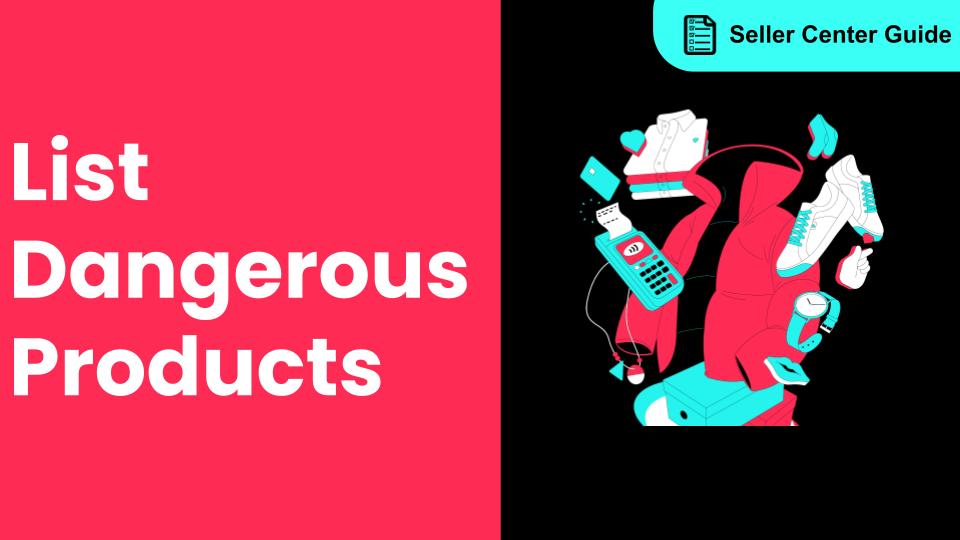
How to List Dangerous Goods
How do I list Dangerous Goods on my shop? We are launching an improved product listing experience to…

Product Ratings
Product Rating overview Product Rating in Seller Center is a seller's one-stop shop to learn what cu…
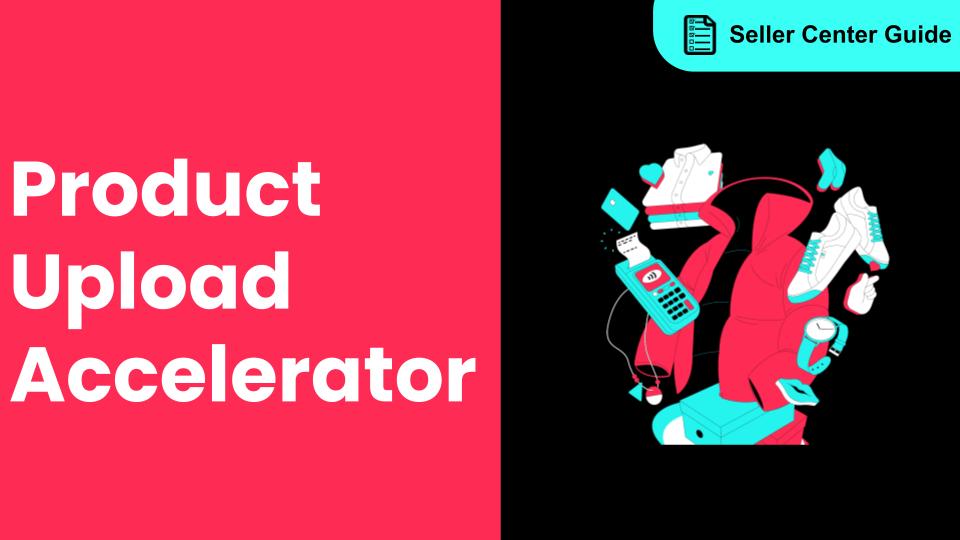
How to Import Product with Product Upload Accelerator
Introduction to Product Upload Accelerator Sellers who operate across multiple e-commerce platforms…